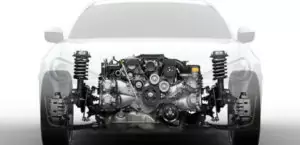The 1.1-liter diesel engine Hyundai D3FA or 1.1 CRDi was produced from 2005 to 2019 and was installed on many compact models of the Korean concern, such as i10, i20, Rio and Picanto. There were two generations of this three-cylinder diesel engine for Euro 4 and Euro 5.
In 2005, a 1.1-liter diesel engine of the U family debuted on the Kia Picanto model, which was a 3-cylinder version of a 1.5-liter diesel engine under the D4FA index. It has a cast-iron cylinder block, an aluminum 12-valve head with hydraulic lifters, a Garrett GT1544V variable geometry turbine, a timing chain and a block of balancers in the sump. There is also a Bosch CRS2 common rail fuel system with a maximum pressure of up to 1600 bar and an intake manifold with swirl flaps. All this allows you to fit into the Euro 4 environmental standards.
The power units of the first generation or U1 were finally discontinued in 2010 and already in 2011 the second generation U2 engines appeared under more stringent Euro 5 environmental standards. They were distinguished by a compression ratio reduced from 17.8 to 16.0, a fuel system with a pressure of 1800 bar and another turbocharger MHI TD025S2 with bypass valve and without variable geometry. Also as an option, these power units were equipped with a proprietary ISG start-stop system.
The Hyundai U family also includes engines: D4FA, D4FB, D4FC, D4FD and D4FE.
The engine was installed on:
- Hyundai i10 1 (PA) in 2008 – 2014; i10 2 (IA) in 2013 – 2019;
- Hyundai i20 1 (PB) in 2012 – 2014; i20 2 (GB) in 2014 – 2018;
- Kia Picanto 1 (SA) in 2005 – 2008;
- Kia Rio 3 (UB) in 2011 – 2017.
Specifications
| Production years | 2005-2019 |
| Displacement, cc | 1120 |
| Fuel system | Common Rail |
| Power output, hp | 75 |
| Torque output, Nm | 153 (1 Gen U1) 180 (2 Gen U2) |
| Cylinder block | cast iron R3 |
| Block head | aluminum 12v |
| Cylinder bore, mm | 75 |
| Piston stroke, mm | 84.5 |
| Compression ratio | 17.8 (1 Gen U1) 16.0 (2 Gen U2) |
| Hydraulic lifters | yes |
| Timing drive | chain |
| Turbocharging | yes |
| Recommended engine oil | 0W-30, 5W-30 |
| Engine oil capacity, liter | 5.7 |
| Fuel type | diesel |
| Euro standards | EURO 4 (1 Gen U1) EURO 5 (2 Gen U2) |
| Fuel consumption, L/100 km (for Hyundai i10 2009) — city — highway — combined |
5.3 3.8 4.3 |
| Engine lifespan, km | ~300 000 |
| Weight, kg | 140.4 |
Disadvantages of the Hyundai D3FA engine
- The main trouble comes from the intake manifold with dampers like Swirl Control Valve, which quickly overgrows with soot and requires cleaning every 50,000 km, as well as the EGR valve.
- The Bosch Common Rail fuel system is quite reliable and there are no big problems with it. Often only the fuel pressure regulator provides, mainly due to banal wear.
- For this power unit, the timing drive consists of a pair of roller chains with tensioners, the resource of which does not exceed 100,000 km, and when they jump, the valves usually bend.
- On the first generation engines, there was an oil burner due to a burst crankcase ventilation membrane. In working condition, it separates the lubricant from crankcase gases and prevents it from entering the intake.
- Also on specialized forums they complain about regular leaks from under the valve cover and the failure of the crankshaft position sensor, but it can usually be revived by cleaning.






